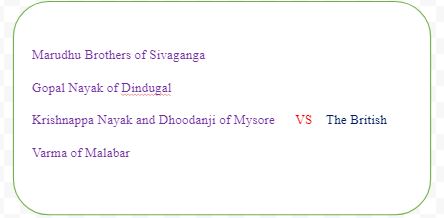PDF chapter test TRY NOW
The Road to Rebellion:
- The death of Kattabaomman is a watershed event that also served as an effective precursor for the impending rebellion. Post his death, his brothers Oomaithurai and Sevathaiah left Panchalamkurichi and wandered in the forest, whom the Marudhu brothers in Sivaganga later gave asylum.
- Slowly after taking ample time for recovery, the Palayakkarars started building their defence forces by taking every small confederacy that was against the British.
- The company troops under Colin Macaulay served an ultimatum to the Marudhu brothers to hand back the brothers of Kattabomman else to face the troops, which the Marudhu brothers firmly denied.
- Colonel P.A. Agnew started his campaign against the Palayakkarars, which was later blown out into a full-scale war.
THE PALAYAKKARAR WAR

The Proclamation of Tiruchirapalli: (1801)
1. The British successfully gained the support of Sivagangai ruler Padmattur Woya Thevar to oppose the Marudhu brothers who were calling for an organised rebellion against the company rule which was known as the Proclamation of Tiruchirapalli or the Call for Independence.
2. To further assert their bravery, the Marudhu brothers asked their men to paste those Call for Independence in the temple of Srirangam and The fort of Tiruchi, which was the place of Arcot’s Nawab.
Divide and Rule: The British used tactical methods to split the forces of Palayakkarars, known as the Divide and Rule policy, whereby separating the forces of unity.
3. The Marudhu brothers collected a huge army against the British, whereby many indigenous rulers like kings of Thanjavur, Pudukkotai were on the other side supporting the British. Thus, the ploy of Divide and Rule by the British worked in their favour.
The Suppression of the Rebellion:
Colonel Agnew took the attack on the Palayakkarars in 1801 by attacking their strongholds in Thanjavur and Kalayarlovil, where the rebels were thoroughly defeated.
The Palyakkarar cannot withstand the might of British forces, and their advanced artillery made them fall like a pack of cards. Many escaped the assault but were later captured and killed.
- Oomaithurai and Sevathaiah, the brothers of Kattabomman, were caught and beheaded in Panchalamkurichi.
- The Marudhu brothers were captured from Singampunary hills and executed.
- Doraisamy, the son of Vellai Marudhu, was caught and killed in a village near Madurai.
- Seventy-three prisoners were deported to Penang in Malaya, known as the “Prince of Wales Island”.
- The Palayakkarar system was later abolished by the British through the Karnataka treaty of 1801.
Despite the failure against the British, these Palayakkarars instilled a sense of bravery and patriotism among the rural people who took their stories to every part of the region through folklore and puppetry.
Dheeran Chinnamalai:
Dheeran Chinnamalai, also known as “Theerthagiri” was one among the Palayakkarars of the Kongu region. This region was under the control of Mysore Sultans. He was trained by Tipu Sultan and the French forces to fight against the British.
Kongu region: The Kongu region is a region in South India that comprises places like Coimbatore, Salem, Karur etc…
After the death of Tipu Sultan, he retreated to Odanilai, where he sought the help of the Maruthu brothers and the Marathas to oppose the British. He planned to attack the British bastions in Coimbatore, where his forces were defeated, and he fled away.
Important battles fought by Chinnamalai:
\(1801\) - Battle on the banks of Cauvery.
\(1802\) – Battle in Odanilai.
\(1804\) – Arachalur battle.
\(1801\) - Battle on the banks of Cauvery.
\(1802\) – Battle in Odanilai.
\(1804\) – Arachalur battle.
Chinnamalai defeated the British forces on the banks of Cauvery by engaging in Guerilla warfare. Later, he was killed during the battle in \(1805\) due to the betrayal of his cook Nallapan, and hanged in the Sankagiri fort.
